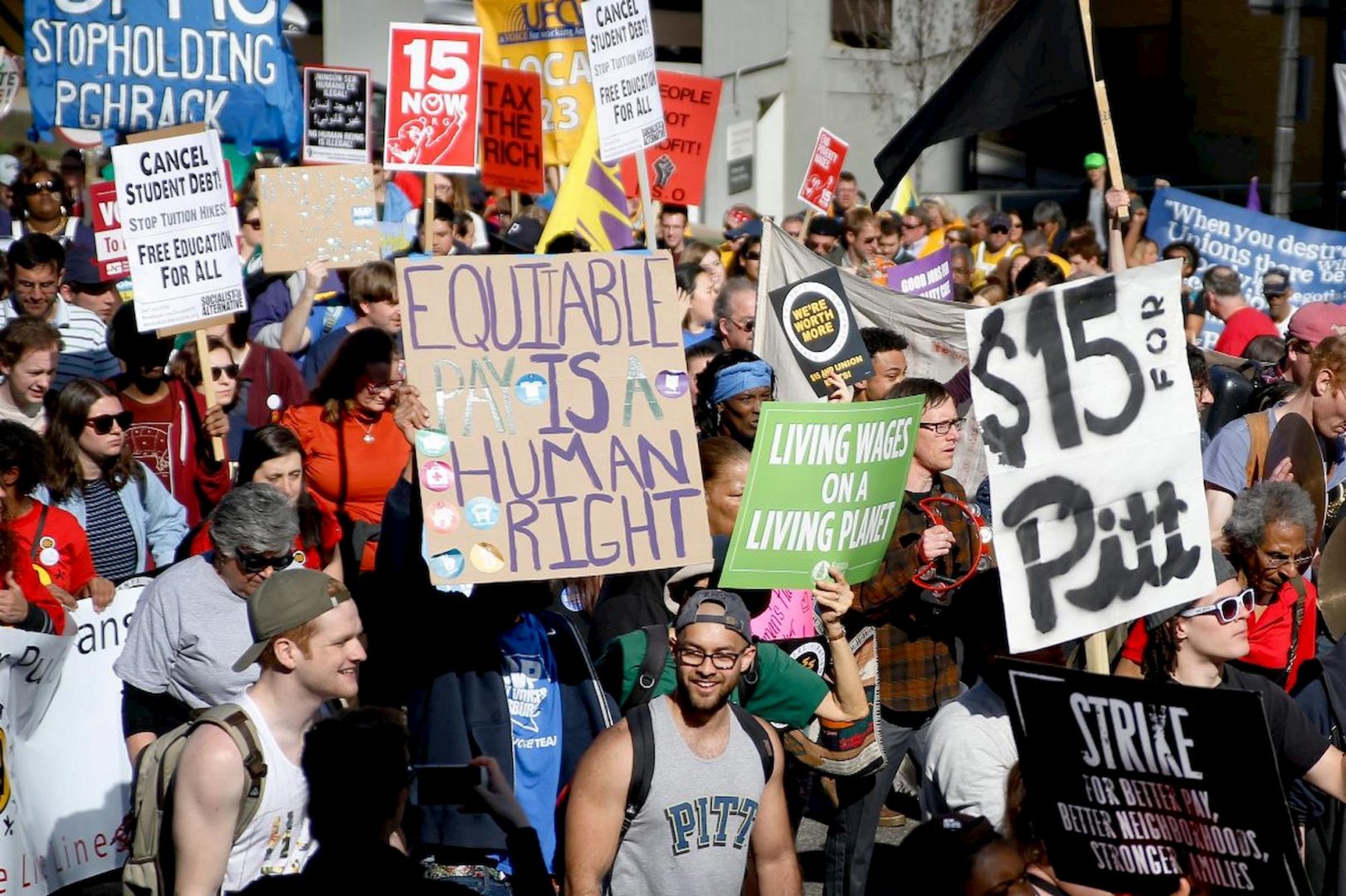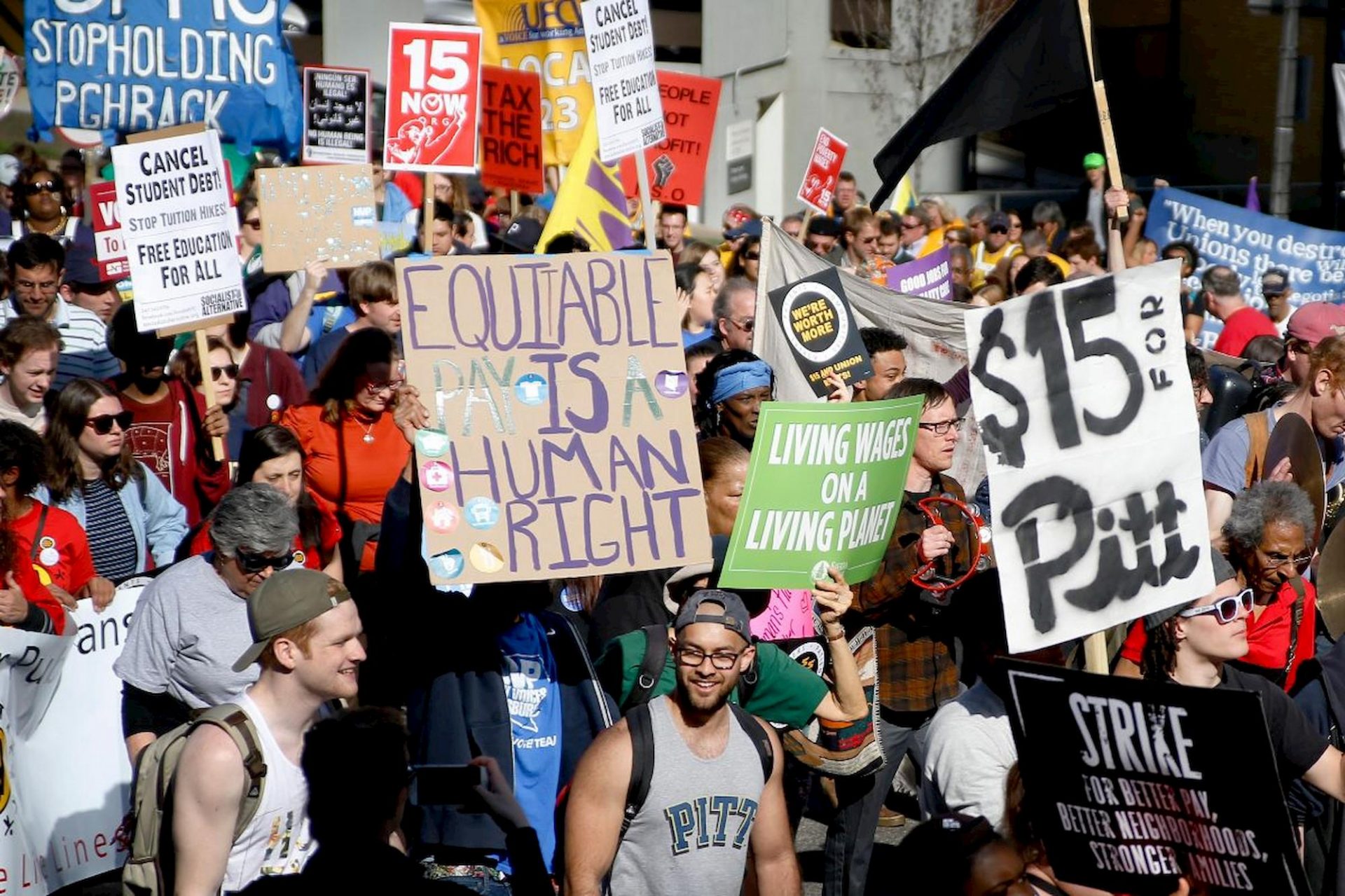
In this April 14, 2016, file photo, union organizers, students, and supporters for a $15 an hour wage march through the Oakland section of Pittsburgh. (AP Photo/Keith Srakocic)
AP Photo/Keith Srakocic

In this April 14, 2016, file photo, union organizers, students, and supporters for a $15 an hour wage march through the Oakland section of Pittsburgh. (AP Photo/Keith Srakocic)
AP Photo/Keith Srakocic

AP Photo/Keith Srakocic
In this April 14, 2016, file photo, union organizers, students, and supporters for a $15 an hour wage march through the Oakland section of Pittsburgh. (AP Photo/Keith Srakocic)

AP Photo/Keith Srakocic
In this April 14, 2016, file photo, union organizers, students, and supporters for a $15 an hour wage march through the Oakland section of Pittsburgh. (AP Photo/Keith Srakocic)
Ron from Atlantic, Pa., wrote in to request that we look at the downsides of raising the minimum wage.
To start, it’s important to differentiate between the federal and state minimum wages. Some states, almost exclusively in the South, don’t have a minimum wage standard (or have one set below the federal minimum), so the default is the federal minimum wage, which is currently at $7.25 an hour.
Many states and cities have minimum wages set well above the federal rate, primarily because costs vary so much between regions. That’s easy to understand: It costs more to live in New York City than State College. In 2017, only 2.7 percent of all American workers were making the federal minimum wage or less.
But what is the point of a minimum wage?
Plainly, it’s to make sure people at the bottom rung of the wage scale earn enough to support their basic needs — housing, food, clothes, utilities etc.. It’s not to get them out of poverty, though some localities or states say they set their minimums high enough to minimize recipients’ reliance on government assistance.
Pennsylvania’s minimum wage is the same as the federal one — $7.25 per hour, an amount that has not increased since 2009. Gov. Wolf says it needs to be higher, and the state Senate approved legislation in the fall to raise it to $9.50 per hour by Jan. 1, 2022. The state House, however, hasn’t shown much appetite for an increase.
Using the Bureau of Labor Statistics’ inflation calculator, the Senate’s proposed increase wouldn’t make up for inflation over the past decade (had the federal minimum wage kept up with inflation, it would currently be set at $10.41).
This is why some people talk about a “living wage,” separate from the minimum wage. Living wages vary based on where a person lives. Using MIT’s Living Wage Calculator, Dauphin County’s living wage is actually $4 above the current minimum wage. It’s even higher in Bucks County, where a living wage is just over $12 an hour.
Getting to Ron’s question: What are the downsides to raising the wage?
We know that the current minimum wage leaves many people in poverty. For example, a father of two earning the minimum wage and working 40 hours a week would make $15,080 annually. That’s almost $6,000 below the federal poverty level. Boosting the wage to $9.50 an hour wouldn’t get the father and his family above the poverty line either (that would require a $10.25 per hour wage).
But wouldn’t unemployment go up? Yes and no.
Growing up, my father ran a few Iranian restaurants in Phoenix. At times when business was slow, he cut staff and worked extra hours himself. Labor was the first to be cut (he even used the rest of the family as free labor, as evidenced by a photo of me as a toddler standing on a box of lettuce to wash dishes in the restaurant kitchen).
Nonpartisan research seems to back up my anecdote. Last year, the Congressional Budget Office found that raising the minimum wage to $15 per hour would left 1.7 million people out of poverty and give raises to 17 million people. But the CBO found such a big increase would also put 1.3 million people out of work. A $10 minimum wage would result in almost no job losses, but wouldn’t help many get out of poverty, the CBO found.
In the end, it’s about balance. Setting the wage too high could force businesses to cut jobs. Setting it too low means many people can’t afford a basic living, putting a strain on government programs and social welfare organizations (and businesses too, if workers don’t have much spending money). Certainly, failing to hike the minimum wage over the past decade — a period of significant economic growth in just about every corner of the country — isn’t helping workers at the bottom of the pile.
Hope that helps, Ron. I know it probably wasn’t the answer you were looking for, but it’s a good start to understanding the economics around the bloated politics with this topic. Plenty of smart people fall on both sides of the minimum wage debate, as evidenced in this thorough explainer from Vox.
Keep your questions coming to our Listening Post. — Joseph Darius Jaafari

Matt Rourke / AP Photo
This Thursday, Sept. 19, 2019, photo shows a spotted lanternfly at a vineyard in Kutztown, Pa. The spotted lanternfly has emerged as a serious pest since the federal government confirmed its arrival in southeastern Pennsylvania five years ago this week. (Matt Rourke / AP Photo)
The winged menace: The spotted lanternfly could cost the state hundreds of millions a year in damages and thousands of jobs, according to a report by students at the College of Agricultural Sciences. The ornamental-plant-eating insect loves hitchhiking in wheel wells, which makes trying to get rid of the multi-colored menace a maddening mess. So far, the insect is costing $50 million a year in damages and 484 lost jobs.
PA senators 50-50: Day 1 of the impeachment trial is in the books. No surprises, as the Senate split cleanly by party when voting on Democrats’ motions to subpoena more documents from the administration and compel testimony from Trump appointees. Pat Toomey, our Republican senator, joined with his party to reject those motions. Bob Casey, our Democratic senator, voted for them. The votes were all 53 to 47. Majority Leader Mitch McConnell is firmly in control of how the trial will proceed.
Missing oversight: The lead sentence of a powerful story published this morning by Transforming Health reporter Brett Sholtis: “Companies that help Pennsylvanians living with intellectual disabilities failed to report two deaths and thousands of other “critical incidents” in 2015 and 2016, according to an audit by a federal inspector general. The same audit concluded that state officials failed to ensure those companies followed the rules.” Read the story.
Journalism that matters: Important news for every Pennsylvanian, as the Reporters Committee for Freedom of the Press announced it will “provide free legal advice to journalists and news organizations in Pennsylvania and four other states to assist in the pursuit of enterprise and investigative stories, The Philadelphia Inquirer reports. Read more from RCFP, Spotlight PA and the Pennsylvania NewsMedia Association.
A task force is created: Katie Meyer reported that Gov. Tom Wolfe named the thirty legislators, academics and judges who would be part of his Juvenile Justice Task Force yesterday. The group will address issues such as detention terms for youth violators along with parole reform for juvenile inmates.
Where your college tuition goes: Drowning in student loan debt is basically my generation’s big mood for life. In a time when university costs are soaring and student debt is bloating to unmanageable proportions, take heed of University of Pennsylvania’s President Amy Gutman, who took in $2.9 million in 2017. Her salary is among the highest in the nation for private colleges — and the highest in Pa. — and is part of the Chronicle of Higher Education’s report that details the salaries of private universities’ presidents. The lowest salary in the state is just under $12,000 for John J. Ryan at King’s College in Wilkes-Barre.
The days of journalism’s one-way street of simply producing stories for the public have long been over. Now, it’s time to find better ways to interact with you and ensure we meet your high standards of what a credible media organization should be.